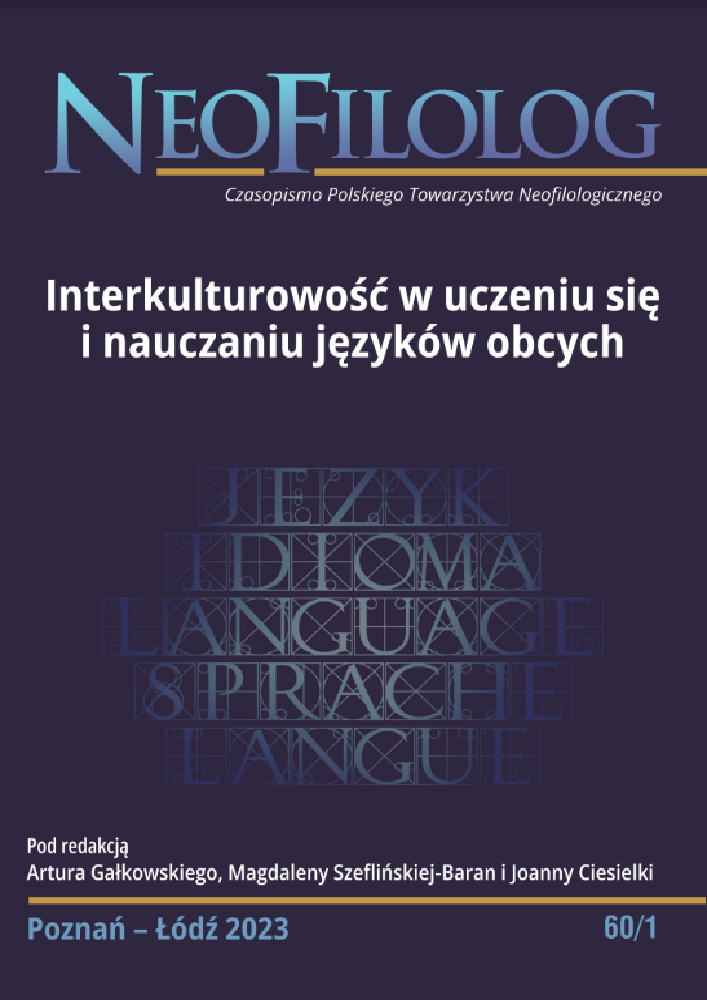Abstract
The aim of the text is to describe the didactic discourse in bilingual education i.e. the actions taken by the teacher in biology and chemistry lessons in relation to the terms the student needs to know and assimilate. The description is based on transcriptions of audio recordings of lessons recorded in one of the bilingual high schools in Warsaw. Basing on selected excerpts from the collected corpus, the author i) shows examples of biology and chemistry terms having different forms in Polish and French and ii) defines the teacher's didactic activities, thanks to which the latter helps the students to properly understand and assimilate the elements of field terminology.
References
Coyle D., Hood P., Marsh D. (2010). CLIL: Content and Language Integrated Learning. Cambridge: CUP. DOI: https://doi.org/10.1017/9781009024549
Dalton-Puffer C. (2011), Content and Language Integrated Learning: From Practice to Principles? “Annual Review of Applied Linguistics”, 31, s. 182-204. DOI: https://doi.org/10.1017/S0267190511000092
Dijk van T. (2001), Badania nad dyskursem, (w:) Dijk van T. (red.), Dyskurs jako struktura i proces. Warszawa: Wydawnictwo PWN, s. 9-44.
Eurydice 2006. L’enseignement d’une matière intégrée à une langue étrangère (EMILE) à l’école en Europe. Bruxelles.
Garcia O., Baetens Beardsmore H. (2009), Bilingual Education in the 21st Century: a Global Perspective. Oxford: Wiley-Blackwell Pub.
Grucza F. (1997), Języki ludzkie a wyrażenia językowe, wiedza a informacja, mózg a umysł ludzki, (w:) Dakowska M., Grucza F. (red.), Podejście kognitywne w lingwistyce, translatoryce i glottodydaktyce. Warszawa: Wydawnictwa UW, s. 7-19.
Grzmil-Tylutki H. (2010), Francuska lingwistyczna teoria dyskursu Historia Tendencje Perspektywy. Kraków: Universitas.
Iluk J. (2000), Nauczanie bilingwalne. Modele, koncepcje, założenia metodyczne. Katowice: Wydawnictwo UŚ.
Janowska I., Plak M. (2021), Działania mediacyjne w uczeniu się i nauczaniu języków obcych Od teorii do praktyki. Kraków: Księgarnia Akademicka. DOI: https://doi.org/10.12797/9788381386807
Marsh D. (2002), CLIL/EMILE – The European Dimensions: Actions, Trends & Foresight Potential. Brussels: European Commission.
Maljers A., Marsh D., Coyle D., Hartiala A.K., Marsland B., Perez-Vidal C., Wolff D. (2002), CLIL/EMILE The European Dimensions – Actions, Trends and Foresight Potential. Jyväskylä: University of Jyväskylä.
Muszyńska B., Papaja K. (2019), Zintegrowane kształcenie przedmiotowo-językowe Content and language integrated learning (CLIL) Wprowadzenie. Warszawa: Wydawnictwo naukowe PWN.
Nocoń J. (2011), Stylistyczne aspekty dyskursu edukacyjnego, (w:) Sokólska U. (red.), Odmiany stylowe polszczyzny – dawniej i dziś. Białystok: Wydawnictwo Uniwersytetu w Białymstoku, s. 187- 200.
Olpińska-Szkiełko M. (2008), Nauczanie dwujęzyczne w świetle badań i koncepcji glottodydaktycznych. Warszawa: Euroedukacja.
Rada Europy (2022), Cadre Européen Commun de référence pour les langues : Apprendre, Enseigner, Évaluer. Volume complémentaire avec de nouveaux descripteurs, online: https://rm.coe.int/cecr-volume-complementaire-avec-de-nouveaux-descripteurs/16807875d5 [DW 02.01.2023].
Skudrzyk A., Warchała J. (2002), Dyskurs edukacyjny a kompetencja interakcyjna, (w:) Porayski-Pomsta J. (red.), Czynności tworzenia i rozumienia wypowiedzi. Studia Pragmalingwistyczne. Warszawa, s. 277-284.
Sowa M., Kic-Drgas J. (2021), La médiation au service de la construction du sens dans l’enseignement d’une matière par l’intégration d’une langue étrangère. « XLinguae », 4, s. 264-281. DOI : 10.18355/XL.2021.14.04.18. Online: http://www.xlinguae.eu/2021_14_4_18.html [DW 29.09.2022]. DOI: https://doi.org/10.18355/XL.2021.14.04.18
Vignaux G. (1988), Le discours, acteur du monde (Enonciation, argumentation et cognition). Paris: Orphys.
Wolff D. (2003), Content and language integrated learning: a framework for the development of learner autonomy, (w:) Little D., Ridley J. Ushioda E. (red.), Learner Autonomy in the Foreign Language Classroom: Teacher, Learner Curriculum and Assessment. Dublin: Authentik, s. 211-222.
Wolff D. (2014), Tworzenie curriculum i kształcenie nauczycieli w dwujęzycznym nauczaniu przedmiotów niejęzykowych, (w:) Dakowska M., Olpińska-Szkiełko M. (red.), Edukacja dwujęzyczna w przedszkolu i szkole. Warszawa: Wydawnictwo IKL@, s. 95-115.
License
Copyright (c) 2023 Magdalena Sowa

This work is licensed under a Creative Commons Attribution-NoDerivatives 4.0 International License.
Authors
Authors of texts accepted for publication in Neofilolog are required to complete, sign and return to the Editorial team’s office the Agreement for granting a royalty-free license to works with a commitment to grant a CC sub-license.
Under the agreement, the authors of the texts published in Neofilolog grant Adam Mickiewicz University in Poznań a non-exclusive, royalty-free license and authorize the use of Attribution-NoDerivatives 4.0 International (CC BY-ND 4.0) Creative Commons sub-license.
The authors retain the right to the free disposal of the work.
Users
Interested Internet users are entitled to use works that have been published in Neofilolog since 2017, under the following conditions:
▪ attribution – obligation to provide, together with the distributed work, information about the authorship, title, source (link to the original work, DOI) and the license itself.
▪ no derivatives – the work must be preserved in its original form. Without the author's consent, it is not possible to distribute the modified work in the form of translations, publications, etc.
Copyrights are reserved for all texts published since 2017.
Miscellaneous
Adam Mickiewicz University in Poznań retains the property right as a whole (layout, graphic form, title, cover design, logo etc.).

